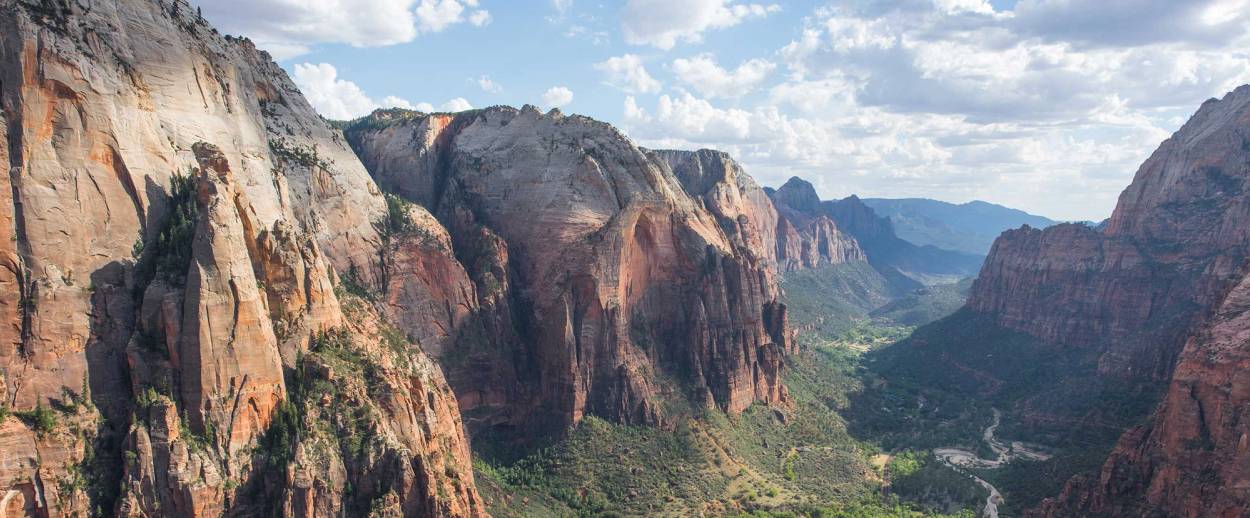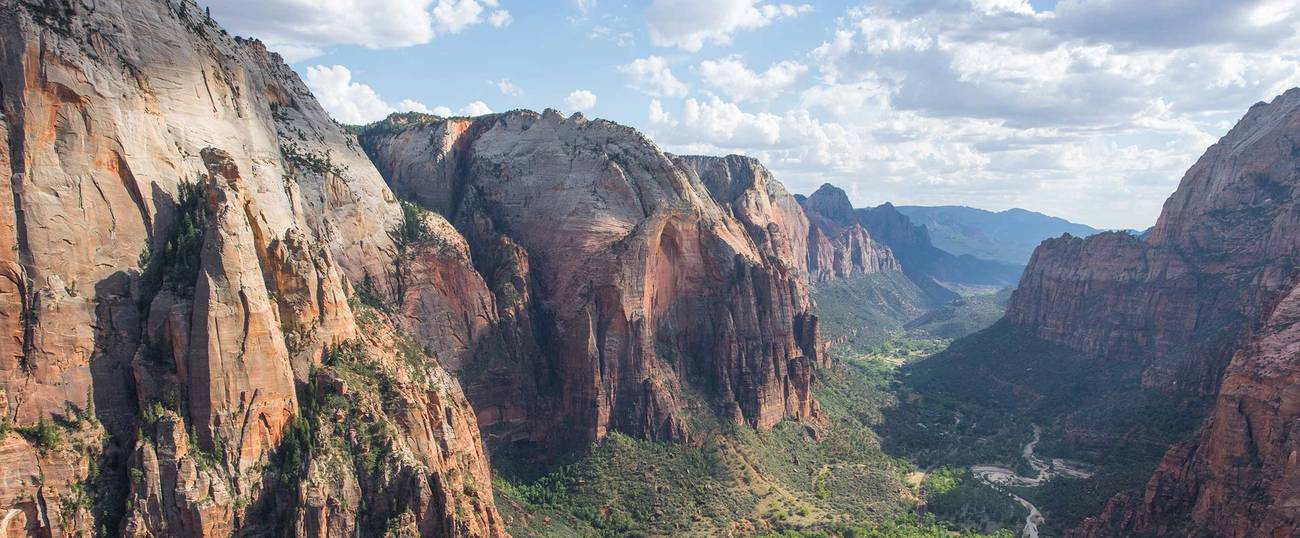Rosh Hashanah in Zion
After I left the Orthodox world—and my marriage—I found a new place to observe the Jewish New Year: on a different kind of path




“How far is it safe to go?” I asked the woman who was renting waterproof boots and walking sticks at the entrance to Zion National Park. It was the first day of Rosh Hashanah and I had come here, along with my husband, to escape this holiday that I no longer observed, and to find a place that might move me in a way that this day never had.
With her finger, she drew a line on the rudimentary map of the Narrows, the narrowest section of Zion Canyon where the Virgin River formed a gorge with rock walls 1,000 feet high on either side.
“Here’s where most people turn back,” she said, pointing to Orderville Gulch, 2.5 miles into the 16-mile-long canyon, parts of which you were only allowed to hike with a permit. I was all too aware of the placards at the visitor center that warned about the risks of hiking the Narrows, where just an inch or two of rain could create a funnel effect that would raise the river to dangerously high levels. “But if you really want to experience the Narrows, you need to keep going, until you reach Big Spring.”
“How much farther is it?” I asked.
“About 45 minutes more,” she estimated, which seemed a small amount of time given that the map said it was another 3 miles. “It’s a shame everyone turns back because the part that comes after is the most beautiful.”
In years prior, I had celebrated every Rosh Hashanah in the women’s section of my in-laws’ Orthodox synagogue, staring out the window and wishing to be anywhere else. I tried to feel moved, but it was a performance I’d seen too many times: Here is the part of the service where you stand. Here you bow. Here you proclaim unwavering belief. I stared into my prayer book, hoping my face revealed none of the deadened, calloused feeling that had overtaken all facets of my religious observance.
I stirred to some kind of wakefulness only when the cantor reached the prayer that lay at the emotional center of the day. On this day it shall be decreed who shall live and who shall die. Who by fire, who by sword, who a timely death, and who an untimely death.
I tried to feel the same awe and fear I once had upon arriving at this part of the service, the feeling that my life lay in the balance. I tried but felt nothing. Observance, I was supposed to believe, would keep us safe, belonging would yield contentment. All my life, I had been taught to believe that repentance and prayers and kind acts could avert the stern decree. I still wanted to believe all of this, any of this, but my lack of faith pressed at me, my doubt excavating a canyon inside me.
After I eventually left the Orthodox world in which I was raised, and my marriage along with it, I was no longer sure how to celebrate Rosh Hashanah. I could still observe some of the holidays in a traditional manner, but not this one. On this day, which had once served as the point of embarkation for my year, I couldn’t stand in synagogue, reciting words I didn’t believe, upholding vestiges of beliefs I had needed to tear down.
The first year after my divorce, I spent Rosh Hashanah at a yoga retreat in western Massachusetts, where I felt relief from what had long felt like constriction, yet I still wanted something else. I needed to be outside.
It was a revelation that took me by surprise. I was hardly outdoorsy, and usually the prospect of a wilderness adventure made me all too aware of the myriad ways there were to get hurt: Who by falling from a kayak; who by encountering wild beasts; who by getting lost on a trail; who by slipping from a ledge. But after all those years of feeling deadened and calloused, I wanted to create a new tradition: to find something every Rosh Hashanah that would move me, shake me, wake me. At the start of every year, I wanted to be surrounded not by community, not by prayer, but by the unmitigated power of the natural world.
At the trailhead for the Narrows, my husband and I set out, quickly hiking the mile-long path that led to the Virgin River. Wading into the river, the water up to my calves, we were surrounded by scores of other hikers, including families with children—more beach outing than any grand adventure.
As we walked, I was dogged not just by the noise but by my awareness of being far away from my own children, who were with their father for these days. (According to our separation agreement, the kids were always with him for this holiday.) They would be at shul now and soon coming home to sit around my former in-laws’ dining-room table, their aunts and uncles and cousins assembled around them. My own parents would be in the shul I had attended every Shabbat of my childhood. Surely traveling so far was an attempt to hide from the loneliness I felt at being away from the kids, at the feeling of no longer belonging to a community. Newly remarried, this was the first time my husband had accompanied me on my Rosh Hashanah adventures, though for him, a secular Jew, this was neither a holiday to observe nor one to hide from. As happy as I was to have him here with me, I couldn’t fully shake the shadow of what used to be—it was a kind of loneliness that no individual or small gathering of people could assuage.
The crowds thinned, the river grew narrower. We walked on. Just water and walls of rock, and between them, a small slice of sky. In the sunlight, the rocks glinted purple and green, as though the river had led us to another planet. Amid the rushing river and the endless rock, it became easier to stop thinking about where I no longer was. Easier to slow the spool of thought and just be inside this place. The urge to take in this landscape had the power of a fierce unmet desire. This, perhaps, was what some felt in shul—that feeling that you wanted to hand yourself over entirely to this beauty. Out here, I felt a loosening of that urge to be closely held by a fixed group; there was no sense of community but there was communion with the wide open world, which I was discovering could be an alternate form of belonging.
After a few hours, the crowds thinned. The river grew deeper. We reached Orderville Gulch. It was tempting to stop here. But the most beautiful part. I looked at my husband. As though we had been bewitched, there was no question. We couldn’t possibly turn back.
The only people in front of us now were a group of hikers in their 20s. Just up ahead of them, a lone man, shirtless, moved expertly across the rocks. We walked on. At a particularly deep spot, where the water reached my chest, I remembered the warnings about flash flooding and scanned for rocks we could climb if we needed to seek higher ground. But surely, I reassured myself, this kind of escape would be unnecessary: The illusion that we were out here alone was illusory. Park rangers wouldn’t allow us to do anything too dangerous. Signs and ropes would warn us back.
We followed the river, deeper inside. The hike had taken on the feeling of a mission, or pilgrimage. We hadn’t noticed when it grew completely quiet, only that it now was. There had been no one to warn us back. We were alone. So much for that estimate of 45 minutes—it had taken far longer already and we didn’t know if we were even close. This surely was when I should have felt fear. If we were more experienced hikers, we would have questioned the wisdom of venturing this far. It had grown cloudy and chilly. Though we’d been walking for hours, I felt as alert, as awake as I ever had. The walking stick that initially seemed like a showman’s accouterment became essential as the current pushed against me. We weren’t lost, not the kind of lost I’d always worried about, in a tangle of streets, in a forest with countless ways to turn. In the Narrows, you could only venture too far, which was its own kind of lost.
But who could turn back? The landscape felt primordial, as though the rest of the world had been stripped away and only the most essential elements remained. We came to a place where the canyon was so narrow, the walls of rock so close together that if we stretched out our arms, we could touch rock on either side. We came to a place where the water was so deep that we climbed onto a ridge along the shore. On the other side, there was no clear way to descend, until I spotted a gap between rocks where, if we took off our backpacks and threw them down, we could just squeeze through and jump down.
Finally, on the left, we came to Big Spring, which, at least at this time of year, was just a small bubbling of water. I stood at the edge of the river and took it in. It didn’t matter that the spring was underwhelming—for me, the most beautiful part was in venturing farther than I felt comfortable, into the uncertainty that lay beyond. This was my Rosh Hashanah. Before I’d left my marriage and the Orthodox community, I’d felt like I was leaving the entire known world. I’d stayed because I wanted to feel secure and safe. I’d been afraid that if I left, I would end up irreparably lost and alone. Yet the answer was in front of me, a reminder I needed at the start of each new year. The world extended far beyond the boundaries of a particular community. There were myriad ways to feel wonder and mystery and awe. In coming to these wild untamed places, I was learning how to be off the path.
As we were sitting on the rocks, eating the soggy sandwiches we’d bought at the small grocery store at the entrance to the camp, the wind blew harder and the sky began to darken. Quickly, we repacked our knapsacks. We turned back, moving as fast as we could across the rocks, swimming when necessary through the water, which seemed deeper than it had just a few hours earlier. Warily, we watched the sky, which was now ominous. It began to drizzle. From above we heard a booming sound, and a rock crashed into the water a few yards in front of us. We started to run. My legs ached. I shivered, wet and cold. Around each bend, I thought that we’d finally reached the starting point, but it was always farther still.
We made it to the entry point as the rain poured down. On the hike back to the main road, there was time to feel amply chastened by the risks we had taken in going too far. But at Zion, the danger was an undeniable part of the beauty. For those hours in the Narrows, I understood. Sometimes the most beautiful parts are just beyond the expected path.
Tova Mirvis is the author, most recently, of The Book of Separation, a memoir.